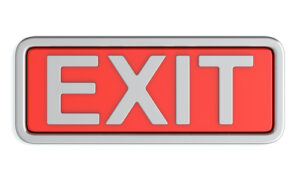Owner obstacles to the implementation of an exit plan are often unconscious, but they can be dramatic. Their attachment to the business can be difficult to break. An advisor spends a lot of time and energy developing the vision for life after ownership in the hopes that it is far more attractive to them than their current role in the business.
 Yet no matter how well developed that vision is, or how well defined the action steps are, it isn’t unusual to find owners who behave in a way that ultimately sabotages the plan. Sometimes their actions are even intentional, but more often they aren’t. The problems arise in two ways.
Yet no matter how well developed that vision is, or how well defined the action steps are, it isn’t unusual to find owners who behave in a way that ultimately sabotages the plan. Sometimes their actions are even intentional, but more often they aren’t. The problems arise in two ways.
“Death from Inattention”
We always ask exit planning clients for two target dates. The first is when they want to be relieved of day-to-day operational responsibilities. The second is when they want to be completely free of any connection to the company.
We tell a client that once we have achieved the first objective, the second may become more flexible. Freed on the task-based duties of running the business, an owner often becomes more strategic. He may start planning for new growth and value creation. She might go back to her role when the business first started when she was the best salesperson or the designer of novel product offerings.
Owners returning to their core skill set are usually a benefit to the business. The problem arises when they enjoy the lack of responsibility so much that they just become owners in absentia.
There is no strategy. The company drifts along on the backs of the operations managers, but doesn’t have a direction beyond “more of what we did yesterday.” There are no new initiatives.
Companies are organic. They are either growing or shrinking. The lack of direction may take a while to have an impact, but eventually, performance will suffer. Getting owners to re-engage after time away can be exceedingly difficult, but if they don’t, the transition is unlikely to accomplish their objectives.
“Death from Over-Attention”
The second obstacle to successfully implementing a transition occurs when owners have surrendered their task-based duties. In this case, they are unable to define their contribution in the absence of being “busy.” They begin looking for ways to contribute, often where their contribution isn’t needed.
It’s not uncommon to begin demanding more accountability and greater detail than is necessary. He or she pours over reports looking for errors, anomalies, or declining results to prove added value.
Another technique used to prove contribution is “seagull management”. An owner may look for opportunities to make decisions but does it without consulting the managers who are in charge of the function. Because they have always known best, they still know best. What isn’t as obvious is that they are now working in a vacuum, with little knowledge of what went before. The results are usually not ideal.
A third way owners might evidence over attention is with a “break the rules” mentality. They offer exemptions from policy or circumnavigate systems because they can. Exercising authority shows who is in charge, even if there is little apparent responsibility.
Preventing the Owner Obstacles
We call these “good” obstacles because they typically occur only after some level of initial success in the exit planning process. They are a direct result of relieving owners of the more mundane duties of management, and freeing them up for more effective leadership. Each is preventable with some preparation.
Either issue can be forestalled by including the owner’s next level of responsibility in the planning process. If the owner resists retained responsibilities, then the future becomes plain. Plans can then include the transfer of higher functions to the management team. If the owner insists on maintaining a level of day-to-day control, the coaching process should include defined parameters about what reporting is essential, and how often it will be presented.
 In either case, owner obstacles occur when the owner is crossing the no man’s land between total focus on the business and the time when it isn’t a recipient of their attention at all. Like any no man’s land, it is unfamiliar territory, and some pathfinding is necessary. That is the exit planning coach’s job.
In either case, owner obstacles occur when the owner is crossing the no man’s land between total focus on the business and the time when it isn’t a recipient of their attention at all. Like any no man’s land, it is unfamiliar territory, and some pathfinding is necessary. That is the exit planning coach’s job.
John F. Dini develops transition and succession strategies that allow business owners to exit their companies on their own schedule, with the proceeds they seek and complete control over the process. He takes a coaching approach to client engagements, focusing on helping owners of companies with $1M to $250M in revenue achieve both their desired lifestyles and legacies.
 When you run your own business, oftentimes one of the most confusing aspects of the job, especially if you are new to the experience, is understanding how to separate yourself from your business. And this issue can show up in so many ways, from achieving a work/life balance and managing your time to how you get paid and even how much taxes you owe.
When you run your own business, oftentimes one of the most confusing aspects of the job, especially if you are new to the experience, is understanding how to separate yourself from your business. And this issue can show up in so many ways, from achieving a work/life balance and managing your time to how you get paid and even how much taxes you owe.

 Often, an NQDC is funded by an insurance policy with a death benefit and an increasing cash value. It is owned by the company, which pays the premiums. At retirement, the employee receives the paid-up policy. This approach has the added benefit of lending confidence to the process, as the employee can see the funding and growth of the future benefit.
Often, an NQDC is funded by an insurance policy with a death benefit and an increasing cash value. It is owned by the company, which pays the premiums. At retirement, the employee receives the paid-up policy. This approach has the added benefit of lending confidence to the process, as the employee can see the funding and growth of the future benefit. We’ve all heard the saying, “Fail to plan, plan to fail.” This is extremely pertinent if you’re thinking about the future of your business. Many owners focus solely on the exit transaction itself without spending the time to properly prepare for it. Transitioning your business can take many forms, from passing to a family member to selling to a strategic partner. Here are some things to think about before you transition.
We’ve all heard the saying, “Fail to plan, plan to fail.” This is extremely pertinent if you’re thinking about the future of your business. Many owners focus solely on the exit transaction itself without spending the time to properly prepare for it. Transitioning your business can take many forms, from passing to a family member to selling to a strategic partner. Here are some things to think about before you transition.